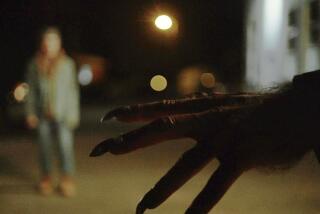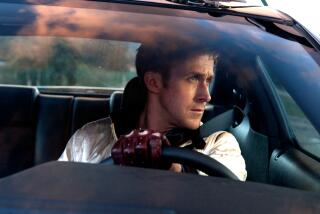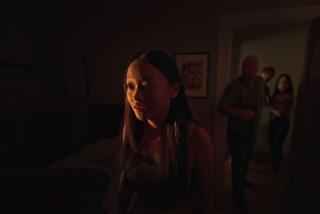‘Nightcrawler’ shows how the news worm has turned
If it bleeds it leads in the fictional newsroom of director Dan Gilroy’s “Nightcrawler.” Fear is an invaluable commodity at KWLA 6, a local Los Angeles news station struggling to pull in ratings post-CNN, Facebook, TMZ, Twitter and everything else that’s rendered regional broadcasts near obsolete.
“Think of our newscast as a screaming woman running down the street with her throat cut,” counsels veteran news director Nina Romina (Rene Russo) to aspiring freelance cameraman Louis Bloom (Jake Gyllenhaal).
Lou, an out of work sociopath in need of a sandwich and shower, has finally found a place where he might fit in — the ethically challenged world of TV journalism. As a stringer, or nightcrawler, he stays up until dawn monitoring police scanners and racing to the scene of tragedies just in time to document the carnage.
And because the hungry cameraman is willing to do just about anything to get the best shot — posing bodies at the scene of a car crash before the police arrive, filming murders in progress — he fast becomes the station’s most dependable provider of grisly, ratings-grabbing footage. “I’m a very quick learner,” he says earnestly through a predatory grin. “You’ll see me again.”
“Nightcrawler,” which opens Oct. 31, was inspired by Gilroy’s fascination with Los Angeles and its especially melodramatic — or some might say absurdly sensationalistic — TV news coverage.
“People in Los Angeles have been fed a diet and are expecting graphic, violent stories,” says Gilroy, who also wrote the screenplay for the film. “I don’t know if it’s self-fulfilling — that the narrative has created the demand or the demand created the narrative.
“It’s a very complex topic. I wouldn’t want to be the one to say this should or shouldn’t happen. If ISIS puts a beheading on the news, I’m not going watch it, but if nine out of 10 people do, does that make it worth showing? I don’t know.”
Open-ended questions about moral responsibility versus ratings infiltrate every aspect of news gathering in “Nightcrawler,” but there’s nothing like a thrilling, high-speed car chase across the city at night to make you forget about the messy business of fair and balanced news.
And the City of the Angels looks particularly ravishing in this nocturnal world. Planes landing at LAX appear magical when viewed through the fronds of palm trees. The Griffith Observatory feels Oz-like towering over the sparkle of Hollywood. Even the dismal bus station downtown shimmers with a sort of ethereal glow, thanks to the cinematography of Robert Elswit (“There Will Be Blood”).
“Nightcrawler” is Gilroy’s first shot at directing after writing screenplays for “The Fall,” “Two For the Money” and “Real Steel.” The Open Road film is also a family affair — he’s married to Russo, and his brothers Tony and John are the film’s producer and editor.
Broadcast news has been at the heart of many memorable films, from “The Insider” to “Network” to “Broadcast News” and yes, even “Bruce Almighty.” But “Nightcrawler,” with its winning combination of darkness and wit, is a rare case where its reporters and anchors are neither truth-seeking heroes nor air-headed twits. They’re simply cogs in a machine that can’t stop churning out tales of terror.
“A narrative built on fear is very effective,” says Gilroy of local news’ propensity to package similar yet unrelated crimes, giving the sense there’s a wave of, say, toddler kidnappings or suburban home invasions. Rarely, though, do we see reports that L.A.’s per-capita crime rate is the lowest it’s been since the 1950s and ’60s. “[That fear narrative] says there are events going on around you, and if you don’t watch this, you don’t have information that will protect you.”
Just how important fear is in informing news decisions has certainly been evident in the last few weeks of expanding war and spreading disease.
Weather, traffic, crime
That may explain why a 2012 Pew poll found that 48% of Americans still regularly tune in, surprising considering no one under 65 readily admits they’re watching local news.
The majority of local newscasts across the U.S. lead their half-hour with the staples of weather, traffic and crime. But according to a 2010 USC Annenberg study by the Norman Lear Center, Los Angeles above most markets prefers crime at the top of its news (and always “breaking”).
Among the eight stations studied, researchers found that “one out of three broadcasts led with [crime].” “Nearly half of those were about murder, robbery, assault, kidnapping, property crime, traffic crime and other common crime. A fourth of the crime leads were about celebrity crime. And nearly a fourth of the crime leads were about crimes that didn’t take place in the Los Angeles media market.”
How often did stories about L.A.-area government lead the news? Two and half percent of the time.
It’s tricky to pinpoint when local news became, well, a punch line (see Jon Stewart’s “Daily Show,” SNL’s “Weekend Update” or “Anchor Man”). Veterans in the industry will say that, until the late 1970s, TV journalism was largely considered a public service rather than a for-profit venture. Once that dynamic changed, the lines between news and entertainment began to blur.
Many of today’s local anchors are part of that show. You’ve seen them — more Jessica Simpson than Jerry Dunphy — perky, beautiful and visually suited for a dating reality show. Yet there they are, delivering stories about deadly carjackings and school shootings under brows that would furrow if they weren’t Botoxed.
Warren Olney was a local weekend anchor and intrepid Los Angeles reporter who began his career in TV journalism in the mid-1960s. “When I started out doing investigative reporting and the sweeps [or ratings] period would come along, the advertising people would come to me and say what have you got, what are you working on that we could use?” recalls Olney, who now hosts KCRW’s “Which Way L.A.” and “To the Point.”
Later in his career, the ad departments “would say our audience surveys show that viewers would like stories about X, Y and Z,” Olney says. “The subjects were being dictated by the sales department rather than rising up from the news department.”
In “Nightcrawler,” the subject of ratings and revenue are at the base of just about every amoral decision made. When a conscientious KWLA assigning director corners Lou to ask him if he broke into a victim’s house to shoot footage, director Nina shuts down her co-worker.
We’ll use it, she says “and knock out a killer package.”
“That’s my job,” retorts the assigning director.
“No, your job is writing the Tweet of the day and getting Deb to turn sideways during the weather forecast. We’re running it.”
More with less
Shot for $8.5 million over 27 days across L.A., “Nightcrawler” is a relatively low-budget film that shows local news operations, like the rest of the American workplace, are doing more with less. That means less investigative reporting and more freelance filler, which is where a jobless Millennial like Lou comes in.
Gyllenhaal lost 30 pounds to play Lou, a character he’s described as “odd and charismatic.”
“He always looked like a coyote in my mind,” Gyllenhaal told the Hollywood Foreign Press. “So I wanted to shape my physical being to fit that. I started eating less, trying to look hungry.”
In another era, the creepy Lou might have been relegated to the mail room. But in modern-day journalism, he’s a celebrated go-getter.
“With Los Angeles crime rates going down,” he tells Nina, “I think items like mine are particularly valuable — like rare animals”
Gilroy is an avid viewer and reader of news on all platforms, and he said he spent countless hours with an actual nightcrawler news crew, brothers Austin and Howard Raishbrook. “We will speed to get to scenes, but we won’t do most of what this character does,” Austin said in press notes for the film.
The horrific scenes they encountered across Los Angeles at night still haunt Gilroy. “Three young girls — they drove off an overpass. A 40-foot drop. Awful.”
Intriguingly, Gilroy also employed the services of talent from inside the news studios.
Former L.A. anchor Kent Shocknek said there are many aspects of the film that feel eerily authentic. Though retired, he plays a newscaster in “Nightcrawler.” Other real-life anchors in the film include KTLA’s Rick Chambers and “Today in L.A.’s” Holly Hannula.
“Every newsroom is different and has its own philosophy,” says Shocknek, a local anchor for more than three decades. “I have been fortunate to work in news departments with people who were skilled in finding stories that our viewers would be most interested in. Audiences are smart. They want to see stories that will affect them. I don’t believe every news department is going to go after the bloodiest story.”
But for those that do, it takes a new breed of cameraman to get the footage that sells. As reprehensible as chasing tragedy may be, Gilroy believes this cut-throat approach isn’t one just relegated to local newsrooms.
“All the qualities that serve Lou well as a nightcrawler are all the same qualities that are celebrated in the board room,” Gilroy says. “It’s an almost a slavish adherence to the bottom line, disregarding human toll or human cost. The person who comes in and breaks up a company for its aggregate parts, puts 50,000 people out of work, then goes and builds an 800-foot yacht winds up on the cover of Business Week celebrated. I feel that whatever crimes Lou does pale in compassion.”
Twitter: @LorraineAli
More to Read
Only good movies
Get the Indie Focus newsletter, Mark Olsen's weekly guide to the world of cinema.
You may occasionally receive promotional content from the Los Angeles Times.







